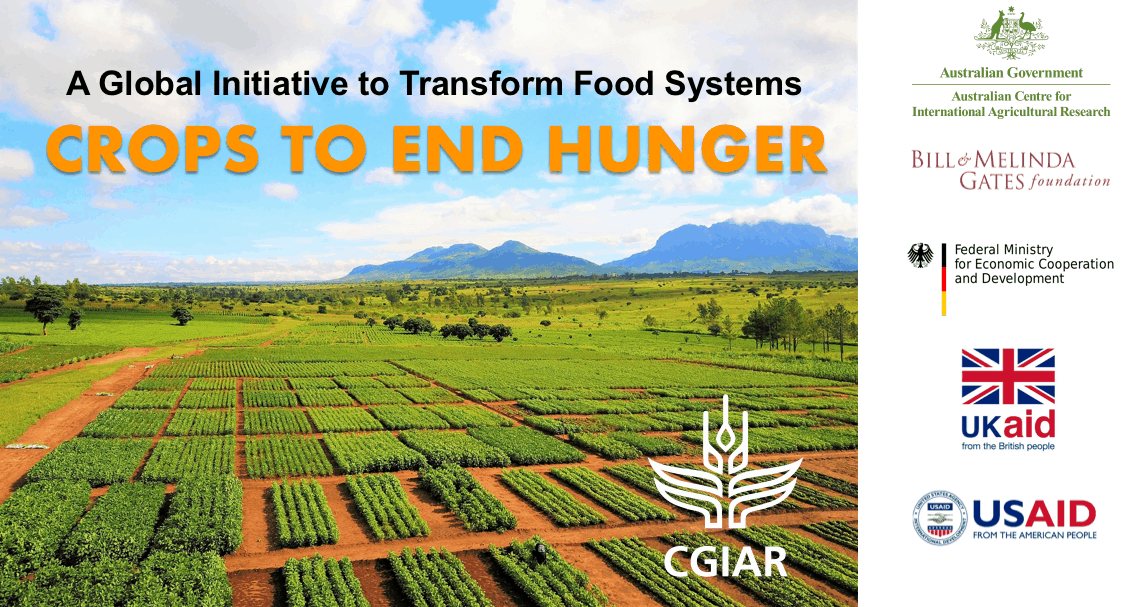
CGIAR Excellence in Breeding (EiB) supports the realization of the full potential of the Crops to End Hunger (CtEH) investment. In 2020, CtEH funders and CGIAR Systems Management Board (SMB) Chair Marco Ferroni announced six requests to CGIAR breeding programs, with EiB leading and supporting delivery of the requests through CGIAR and national breeding partners.
Summary:
Crops to End Hunger (CtEH)’s overall objective is to modernize CGIAR breeding programs and networks to ensure that they deliver the highest possible rate of genetic gains in farmers’ fields, in the form of nutritious, climate-resilient, market-demanded cultivars. To this end, the Funders are making six specific requests to Centers:
- Develop pipeline investment cases.
- Incentivize management and staff to deliver higher genetic gain.
- Develop strategic plans for delivery to farmers and varietal turnover
- Quantitatively optimize pipelines to increase genetic gain.
- Implement shared services.
- Build NARS breeding networks and capacity.
CGIAR Excellence in Breeding (EiB) supports the realization of the full potential of CtEH investment and leads and supports the efforts to successfully respond to these requests.
Details of each request:
1. Develop pipeline investment cases: Develop and present an investment case for each of the pipelines/product profiles managed by the Center that provides enough detail to allow Funders to allocate specific amounts of funding to specific product profiles. Breeding programs must be accountable for the delivery of these products targeting discrete populations of farmers, prioritized based on a quantitative investment case setting out the potential of the product to alleviate poverty and improve livelihoods. Information provided would include:
a. The products that Centers will be held accountable for developing (the product profiles).
b. The varieties currently in the marketplace that will be replaced and in which geographical location.
c. The expected impact of these products, including:
• Number of farmers targeted and their depth of poverty.
• Consumers served by the pipeline and their depth of poverty.
• Area, amount, and value of production.
• Contribution to farming systems intensification, sustainability or reduction of risk
• Climate change mitigation and adaptation.
• Contribution to human nutrition.
• Any other important and relevant information.
d. Details about the breeding scheme used to deliver these products, such as costs of individual operations, number of selection candidates, plots, locations, etc. and overall annual operating costs of a program designed to deliver 1.5-2.0 percent annual genetic gain.
e. A description of the pathway to market, from development by the breeding program to being grown in farmers’ fields, including the level of functionality, security and sustainability of this pathway. Who are the actors, how does this work and what is the handover mechanism? Should include details such as commentary on the quality of data farmers have access to for making variety choices.
f. A description of other breeding pipelines operating in the same market segments and the quality of germplasm being delivered by these breeding pipelines.
g. The total current level of funding available for each breeding pipeline.
2. Incentivize management and staff to deliver higher genetic gain: Align management and staff incentives to the goal of delivering high rates of genetic gain in the form of farmer- and market-preferred products. Management needs to support high-functioning breeding teams designed to deliver products and support NARES. This will require:
a. Empowered Breeding Leads, with full integration of genetic analysis and breeding under one management structure, led by the Breeding Leads.
b. A formal advancement system for identifying the products (final or intermediary) in each pipeline that will be supported for dissemination.
c. A system for prioritizing genetic research investments and outputs so that they serve the product development pipelines, with fully articulated systems for ensuring that valuable new alleles are efficiently deployed.
d. Key performance indicators (KPIs) that are clearly understood by both breeding teams and Center management (i.e. DGs and DDG-Rs), and that permit pipeline performance to be assessed by management.
e. Staff evaluation systems that emphasize successful delivery of genetic gains, and that encourage focus by not including metrics that are not aligned with delivery of genetic gains.
3. Develop strategic plans for delivery to farmers and varietal turnover: Develop an overall strategic plan for the continuous development of varieties that will ultimately reduce the area weighted average age of varieties in farmers’ fields. This plan must indicate in detail how the strategy will be operationalized and achieved with national partners and delivery pipeline participants (i.e. the private sector).
4. Quantitatively optimize pipelines for increased genetic gain: Design and implement pipelines that are quantitatively optimized to deliver the highest possible rates of genetic gain with the resources available.
5. Implement shared services: Participate in the design and implementation of shared breeding support services system-wide, in anticipation of One CGIAR, that will prevent duplication and provide CGIAR breeding programs with greater bargaining power in purchasing or contracting equipment, genotypic services, and software.
• E.g. the High-Throughput Genotyping Project managed by the EiB, which has successfully negotiated and implemented genotyping service contracts for the whole system (and NARS partners) that have greatly reduced the cost of diagnostic SNP genotyping for CGIAR and NARS breeding programs, allowing routine use of markers in forward breeding.
• Similar initiatives needed for occupational health and safety, phenotyping processes, seed storage, information management.
6. Build NARS breeding networks and capacity: Implement a consistent approach across crops to engaging with and supporting the improvement of national breeding programs, especially in regions with weaker NARS such as sub-Saharan Africa. A clear division of labor and best practices for network management are needed, with the goal of moving CGIAR breeding programs “upstream” as providers of high-value haplotypes and elite parents with high breeding value, and supporting NARS in developing, validating, and disseminating finished commercial varieties.